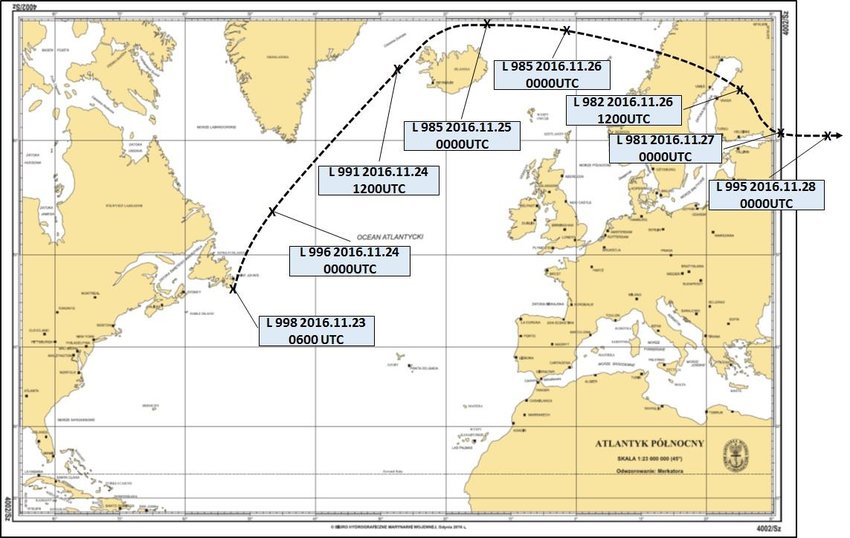
Introduction:
The world’s oceans, vast and interconnected, serve as critical arteries for global trade, connecting nations and fostering economic prosperity. Among these maritime highways, the North Atlantic Route stands as the busiest and most strategically significant sea route. This comprehensive article delves into the historical, economic, geopolitical, and environmental dimensions of the North Atlantic Route, shedding light on its unparalleled importance in shaping the dynamics of international trade and navigation.
I. Historical Significance:
- Exploration and Early Navigation: The North Atlantic Route has a rich history rooted in exploration. From the daring voyages of Christopher Columbus to the Norse expeditions led by Leif Erikson, this route witnessed the early encounters that shaped the course of world history.
- Colonial Expansion and Trade Routes: The Age of Exploration and subsequent colonial expansion established the North Atlantic Route as a crucial conduit for trade between the Old and New Worlds. The so-called “Triangular Trade” linked Europe, Africa, and the Americas, laying the foundation for the global trade networks that would follow.
II. Economic Backbone:
- Global Trade Hub: In the contemporary era, the North Atlantic Route has evolved into the economic backbone of the world, facilitating the movement of goods, raw materials, and energy resources. The route connects major economic powerhouses, including North America, Western Europe, and the Arctic region.
- Shipping Lanes and Maritime Traffic: The North Atlantic boasts some of the busiest shipping lanes globally, with a constant flow of vessels transporting a diverse array of cargo. The route facilitates the exchange of goods ranging from manufactured products and machinery to energy resources, agricultural commodities, and consumer goods.
III. Strategic Geopolitical Position:
- Strategic Importance: Geopolitically, the North Atlantic Route is of paramount significance. It connects major geopolitical players, including the United States, Canada, Western European nations, and Arctic countries. The control and strategic positioning along this route can influence global maritime dominance.
- Military Presence and Security Concerns: The presence of powerful naval forces, including those of NATO member states, underscores the military importance of the North Atlantic. Issues related to maritime security, piracy, and geopolitical tensions add layers of complexity to the strategic considerations surrounding this critical sea route.
IV. Environmental Challenges:
- Melting Arctic Ice: Climate change has had a profound impact on the North Atlantic Route, particularly in the Arctic region. The melting of polar ice has opened new passages, presenting both opportunities and challenges for navigation. The Northwest Passage, once impassable, has become increasingly accessible during certain parts of the year.
- Environmental Conservation Concerns: The environmental challenges posed by increased maritime traffic include the risk of oil spills, disturbance to marine ecosystems, and the potential for invasive species introduction. Balancing economic interests with environmental conservation has become a pressing issue for stakeholders in the region.
V. Technological Advancements:
- Navigation Technology: Advancements in navigation technology have played a pivotal role in enhancing the safety and efficiency of the North Atlantic Route. From satellite-based navigation systems to sophisticated weather forecasting, these technological innovations have contributed to smoother and more reliable maritime operations.
- Icebreaker Technology: In the Arctic region, where icy conditions can pose challenges, icebreaker technology has become essential for maintaining navigable passages. Icebreaking vessels equipped with advanced capabilities ensure the safe transit of ships through frozen waters.
VI. Future Trends and Developments:
- Arctic Shipping Opportunities: The ongoing retreat of Arctic ice is opening up new opportunities for Arctic shipping along the North Atlantic Route. As the ice recedes, the potential for shorter transit times between Europe and Asia via the Arctic becomes a tantalizing prospect for the shipping industry.
- Sustainable Navigation Practices: With growing awareness of environmental conservation, there is a trend toward sustainable navigation practices. Stakeholders are exploring ways to minimize the ecological impact of maritime activities along the North Atlantic Route, including adopting cleaner fuels and implementing eco-friendly shipping technologies.
VII. Economic and Social Impacts:
- Regional Economic Growth: The economic impact of the North Atlantic Route extends beyond individual nations. The interconnectedness of economies along the route has led to regional economic growth, job creation, and increased prosperity for communities dependent on maritime activities.
- Cultural Exchange and Connectivity: The North Atlantic Route serves as a conduit not only for goods but also for cultural exchange. Maritime activities foster connectivity between diverse cultures, promoting understanding and collaboration among nations sharing this vital sea route.
VIII. Challenges and Risks:
- Security Concerns: Maritime security remains a constant challenge along the North Atlantic Route. Issues such as piracy, smuggling, and potential terrorist threats require vigilant efforts from naval and security forces to maintain the safety and integrity of the sea lanes.
- Environmental Impact: The environmental impact of increased maritime traffic, including the potential for oil spills and disruption to marine ecosystems, poses a significant challenge. Balancing economic interests with sustainable practices is imperative to address these concerns.
IX. Conclusion: Sailing into the Future
In conclusion, the North Atlantic Route stands as a testament to the dynamic interplay between history, economics, geopolitics, and environmental considerations in the realm of maritime navigation. From its historical significance in the age of exploration to its pivotal role in contemporary global trade, the North Atlantic Route remains a lifeline for nations connected by the ebb and flow of the ocean. As technological advancements, climate change, and evolving geopolitical landscapes shape the future of this crucial sea route, stakeholders must navigate the challenges and opportunities that lie ahead. The North Atlantic Route, with its complex tapestry of past and present, continues to chart the course for the global maritime landscape, sailing into the future with both promise and responsibility.